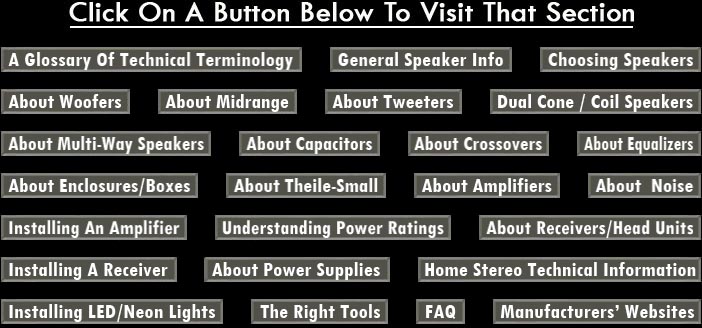


Near Field Sound
Typically, any point where the direct sound emission is measurably louder than the reflections of that sound. From a more accurate technical perspective, this is the point where the velocity of molecules emitted by the radiator is out of phase with the sound pressure wave. This is especially obvious when the listener is in close proximity to high frequency emissions.
Negative feedback
The dynamic comparison of a fraction of the output signal to the input signal at the input to an amplifier in such a way that the amplifier regulates it's output signal for maximal conformity to the input signal. Negative feedback is frequently used in designing opamp circuits and audio power amplifiers.
Negative LCD
A liquid crystal display employing a dark backfield with lit elements. This results in a primarily dark display, which improves cosmetic integration with a dark colored headunit.
Neodymium Magnet
A magnet material providing 7.5 times the magnetic strength of standard magnetic materials.
Net Volume
The amount of airspace that is enclosed within a speaker's enclosure. This does not include the airspace taken up by bracing, vents, or the speaker itself.
Noise
Perceived sounds not in the original soundtrack. Such things as hiss, crackle, pops, hum, and buzz, are typical of the types of extraneous signals described as noise. Inherent noise in the electronic processing in any sytem is measured in decibels relative to the amplitude of the original signal.
Sounds perceived as noise are heard in contrast to the sound that is the object of attention. Thus, a noise signal measured at 15 deciBels below the output of Tchaikovski's 1812 Overture finale would probably not even be heard; while a slight hiss at 55 dB below the level of a soft piano passage would be annoyingly obvious.
Generally, any piece of equipment which generates ambient noise of more than 90 dB below the level of a typical audio signal is noise free as far as most human perception is concerned. (also see Getting Rid Of Noise)
Noise floor
Normally the lowest threshold of useful signal level (although sometimes audible signals below the noise floor may be recovered).
Noise gate
An expander with a fixed "infinite" downward expansion ratio. Used extensively for controlling unwanted noise, such as preventing "open" microphones and "hot" instrument pick-ups from introducing extraneous sounds into the system. When the incoming audio signal drops below the user set-point (the threshold point) the expander prevents any further output by reducing the gain to "zero." The actual gain reduction is typically on the order of -80 dB, thus once audio falls below the threshold, effectively the output level becomes the residual noise of the gate. Common terminology refers to the gate "opening" and "closing." Another popular application uses noise gates to enhance musical instrument sounds, especially percussion instruments. Judicious setting of a noise gate's attack (turn-on) and release (turn-off) times adds "punch," or "tightens" the percussive sound, making it more pronounced.
Non-Delay Play
A disc changer feature with significantly reduced silence between the time one disc is finished, and the next disc is loaded and cued.
Nominal Impedance
The minimum impedance a loudspeaker presents to an amplifier, directly related to the power the speaker can extract from the amplifier.
Non-Lossy Compression
A form of data compression which seeks out chunks of data which are identical, replacing them with markers called keys. In this way, the file is reduced in size, and when it is decompressed by the recipient, the keys are replaced with the large chunks of data that were originally there (this is called Run Length Encoding). Using non-lossy compression, the uncompressed file is identical to the original file.
Notch filter
A special type of cut-only equalizer used to attenuate ( no boosting ) a narrow band of frequencies. Three controls: frequency, bandwidth and depth, determine the notch. Simplified units provide only a frequency control, with bandwidth and depth fixed internally.
NTSC
National Television System Committee. Refers to the standards used for video broadcast and playback signal parameters in the U.S. Japan and other countries. Alternative systems used in Europe and some Asian countries are PAL and SECAM.
Nyquist's Theorem
This states that a sound must be sampled at at least twice its highest analog frequency in order to extract all of the information from the bandwidth and accurately represent the original acoustic energy. In practice, sampling at slightly more than twice the frequency will make up for imprecisions in filters and other components used for the conversion.















